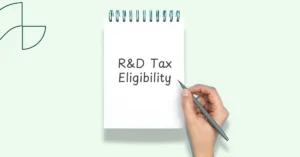Engineering Firms: Maximise 2024 R&D Tax Credits with These Tips

Maximise Your R&D Tax Credits For Engineering Firms 2024
Engineering continues to be one of the most innovative industries, but did you know that if your research is based in the UK then these innovations could be eligible for R&D tax incentives? Throughout this post, we’ll explore the importance of R&D tax credits, the benefits they have on engineering companies and how you can get expert guidance throughout your R&D claim.
What Are R&D Tax Credits?
R&D tax credits are government funded tax incentives that exist to financially assist companies that are making an effort to advance their fields through research and development. Through these incentives, engineering companies have the ability to solve industry related problems without a substantial financial risk hanging over them.
Definition and Purpose
Back in the year 2000, the British government wanted to be able to encourage UK based companies to invest in innovative projects that would enhance their field. The idea was to build the foundations that would eventually see the UK as a hub for scientific and technological growth. And so, R&D tax credits were formed.
The R&D tax credit scheme reimburses eligible companies for their revenue expenditure in relation to research and development activities. This means that a percentage of the money spent on the following could be claimed under the R&D tax incentive scheme:
- PAYE staff costs
- R&D related travel costs
- Materials & consumables
- R&D related software
- Subcontractor costs
- Utility bills
Benefits for Engineering Companies
Engineering innovation can be costly, but with R&D tax credits, companies can reduce the financial burden of their research and development by claiming a portion of the expenditure. With the reduced burden, the risks often associated with R&D activities are drastically reduced, making way for more ambitious and experimental advancements.
By giving engineering companies the ability to invest without the weight of financial risk, R&D tax credits encourage engineering firms to remain competitive throughout the global market. Furthermore, these credits are available to eligible companies that may be operating at a loss, ensuring that there is vital support for businesses that may be in a lean period.
Essentially these incentives support the growth and longevity of the engineering sector, while directing economic growth and industrial progress throughout the UK.
HMRC Guidelines for Eligibility
HMRC defines research and development as a project or activity that aims to achieve a scientific or technological advance within the industry of the company that is carrying out the research and development. Put simply, a research and development project should aim to overcome a scientific or technological uncertainty that cannot easily be overcome by experts in the field.
While a wide variety of businesses undergo research and development activities, only those that are liable for UK corporation tax are eligible for R&D tax credits. This means that while SMEs (small and medium sized enterprises) and large companies can make a valid claim for their activities, sub-contractors may not be able to claim for their work on R&D projects.
Meeting these guidelines is absolutely essential to your claim, as it defines the accuracy of both your work and your claim. Considering each claim could be subject to scrutiny, being aligned with the necessary criteria from the outset can be highly impactful on all future R&D endeavours.
Eligibility Criteria for Engineering Projects
As engineering is such a diverse field, the scope of R&D activities is understandably wide. To give you an idea of what kind of engineering projects qualify as research and development, let’s take a look at some of the criteria and projects that could qualify for R&D tax credits.
Qualifying Engineering Projects
The criteria that engineering companies must meet are fairly straightforward. Not only must the projects aim to resolve uncertainties using science and technology as stated above, but they must also align with the company’s field of expertise. Given that engineering holds many specialities, this means that your project must align with both engineering and the industry with which you exclusively work.
Examples of Qualifying Activities
When it comes to engineering and R&D there are more qualifying projects than simply the development of goods. This is why the following activities are some of the most popular advancements that engineering companies venture into:
- Developing new manufacturing processes
- Designing advanced robotic systems
- Creating novel materials
- Developing renewable energy solutions
Each of these projects align with HMRC’s criteria for engineers, as they all aim to use industry based expertise in order to resolve technological uncertainties.
Documentation Required
While HMRC states that they require financial records and project documentation, their description of necessary documentation for an R&D tax credit claim remains a little scarce. As R&D tax specialists, we at Alexander Clifford recommend that a claim includes the following to be successful:
- Project descriptions
- Technical reports
- Financial records
- Supporting documentation
- Tax computations
As we believe that these documents are necessary to making a successful R&D claim, we ensure that this is a part of the claiming process when working with our clients.
Common Misconceptions About R&D Tax Credits in Engineering
As with anything, there are myths and misconceptions surrounding R&D tax credits and engineering. To set the record straight, we’re going to take a quick look at a few of the most common misconceptions.
Addressing Myths
If you’re new to R&D, you probably feel a little overwhelmed with all the information that is flying your way. With contradicting statements and a flurry of people telling you what does and does not qualify, it’s easy to get lost. So we turned to our experts in order to help you understand the facts about R&D tax credits. Here are a few of the most common misconceptions:
Misconception 1: Routine engineering doesn’t qualify
If your R&D project doesn’t involve a high tech innovation, you are not going to get left behind! Remember that your engineering project should aim to resolve a technical or scientific uncertainty – meaning so long as your activities have this aim, they may be eligible for R&D tax incentives.
Misconception 2: R&D projects must be successful to qualify
As long as your project seeks to achieve an advance, HMRC may deem it a qualifying research and development project even if it fails. This is because the R&D tax credits scheme exists to encourage innovation – and without failure, there can be no growth.
Misconception 3: Only product development counts
Of course products are important, but they are not the crux of R&D tax credits. However qualifying research and development projects could seek to improve processes, develop software, and even solve technical problems. All of these projects are deemed to be technological advancements, so it’s fair to say that your engineering projects do not have to include the manufacturing of products.
Case Studies
In order to give you an accurate representation of some engineering projects that were successful in making an R&D tax credit claim, we’re taking a look at some of our previous clients here at Alexander Clifford. In this, we’ll explore the basic overview of the project and how it qualifies as research and development according to HMRC.
Battery Manufacturing Case Study
The aim of this client’s project was to develop safe, environmentally and affordable energy storage solutions, ready for market. This required specialist engineering in order to develop a product that could replace the industry standard lead-acid battery.
As this project involved intense research and the element of uncertainty that is central to an R&D claim, our team was able to work closely with this client in order to build a successful claim that led to a substantial client benefit.
Inventory Management Software Case Study
This particular client’s project aimed to develop a platform that executes smart contracts for moving and warehouse storage, specifically for e-commerce and retail. In order to successfully develop the platform, they required a software engineer as a part of their core team.
Given that this project aimed to simplify a process and therefore bettering the client’s industry using technology, their activities were eligible for R&D tax incentives. As a result, we were able to compile a successful R&D claim on their behalf which led to a great return on their investment into the project.
Alexander Clifford’s No Win, No Fee Model
As R&D tax specialists, we assist companies in making claims to HMRC in relation to their research and development projects. Offering unwavering support throughout the claiming process, we operate on a “no win, no fee” model.
Understanding the Model
We understand that you’ve already made a great investment into your research and development activities, so to ensure that you feel comfortable as you work with our consultants, all of our services operate on a “no win, no fee” basis. This means that we won’t charge you a penny until you receive your entitlement from HMRC.
Given our high success rate in making R&D tax credit claims, we believe that any company that passes our initial assessments will likely succeed in making a claim for R&D incentives.
Benefits for Engineering Companies
Engineering companies can seek many benefits from our “no win, no fee” model, as it ensures a level of safety surrounding finances. Without the burden of having to pay out consultants fees if the claim is unsuccessful – which is rare – engineering companies take on no financial risk when choosing to work with Alexander Clifford for their R&D tax credit claims.
Frequently Asked Questions (FAQs)
Still have some questions about R&D tax credits and engineering? We discovered some of the most frequently asked questions in order to help you gain more clarity.
How long does it take to receive R&D tax credits?
Typically after compiling and submitting a claim, it takes HMRC around 4-6 weeks to process it. During peak times however, the processing time may be longer. Following a successful process, payment is usually made within 14 days.
Can small engineering firms claim R&D tax credits?
As long as the small engineering firm is liable to pay corporation tax, all projects that align with HMRC’s definition of research and development will be eligible for R&D tax incentives.
Are R&D tax credits for engineering firms taxable?
As R&D tax credits are a reimbursement of costs incurred on research and development projects, they are not taxable.
How often can engineering firms claim R&D tax credits?
Many R&D projects have multi-year extensions, meaning that as long as you have expenditure that falls within the parameter of the guidance, these projects can be used in more than one R&D tax claim. This means that you can take the same approach each year that is shown within your supporting documents (as long as the costs and descriptions change) and then can proceed to submit your application.
How can Alexander Clifford help with my engineering R&D tax credit claim?
We make R&D tax claims simple. We’re able to do this by helping you to gather the necessary documentation and financial records, before we compile your claim. What’s more is that we keep in touch with HMRC, acting as your liaison so that you can remain updated throughout the claims process without feeling overwhelmed by any additional requests.
This is what makes Alexander Clifford your trusted choice for R&D tax credits.
In conclusion, your engineering company has the ability to invest in research and development without taking on a major financial burden. Not only does this allow your company to solve integral uncertainties throughout the field of engineering, but it also positions your engineering company as a leader in the global market.
So if you’re an engineering company and you’ve been involved in R&D projects, get in touch with us to learn more about how we can help you with your claim.







